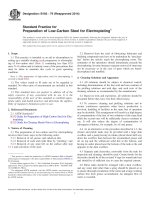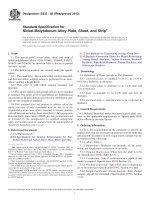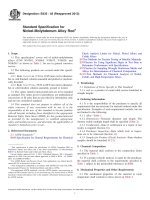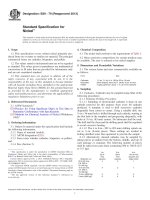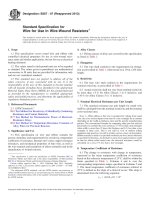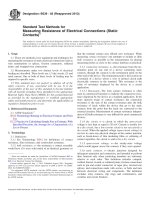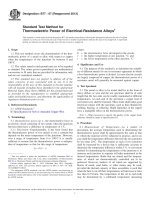Astm b 39 79 (2013)
Bạn đang xem bản rút gọn của tài liệu. Xem và tải ngay bản đầy đủ của tài liệu tại đây (70.89 KB, 3 trang )
Designation: B39 − 79 (Reapproved 2013)
Standard Specification for
Nickel1
This standard is issued under the fixed designation B39; the number immediately following the designation indicates the year of original
adoption or, in the case of revision, the year of last revision. A number in parentheses indicates the year of last reapproval. A superscript
epsilon (´) indicates an editorial change since the last revision or reapproval.
1. Scope
4. Chemical Composition
1.1 This specification covers refined nickel primarily produced from ore or matte or similar raw material. The principal
commercial forms are cathodes, briquettes, and pellets.
4.1 The nickel shall conform to the requirements of Table 1.
4.2 More restrictive compositions for certain products may
be available. The user is referred to his nickel supplier.
1.2 The values stated in inch-pound units are to be regarded
as standard. The values given in parentheses are mathematical
conversions to SI units that are provided for information only
and are not considered standard.
1.3 This standard does not purport to address all of the
safety concerns, if any, associated with its use. It is the
responsibility of the user of this standard to become familiar
with all hazards including those identified in the appropriate
Material Safety Data Sheet (MSDS) for this product/material
as provided by the manufacturer, to establish appropriate
safety and health practices, and determine the applicability of
regulatory limitations prior to use.
5. Dimensions and Permissible Variations
5.1 The various forms and sizes commercially available are
as follows:
Form
Cathodes
Briquettes
Pellets
Size
11⁄2 by 11⁄4 by 5⁄8 in. (38 by 32 by 16 mm)
pillow shaped, about by in. (38 by 32 by 16 mm)
roughly spherical, about 1⁄4 in. (6.3 mm) diameter
6. Sampling
6.1 Cathodes—Cathodes may be sampled using either of the
following procedures:
6.1.1 Template Drilling Procedure:
6.1.1.1 Sampling of electronickel cathodes is done on one
cathode removed for this purpose from every 60 cathodes
produced. A template is used to drill successive cathodes
diagonally from corner to corner. Using a suitable drill, one
5⁄8-in. (16-mm) hole is drilled through each cathode, starting at
the first hole in the template and progressing diagonally, with
holes at 31⁄4-in. (83-mm) centers. No lubricants shall be used.
The drill shall be clean and the drilling speed shall be regulated
to avoid excessive heating.
6.1.1.2 The 4 to 8-in. (102 to 203-mm) drilling spirals are
cut to 1⁄4-in. (6-mm) pieces. These cuttings are washed in
boiling distilled water then quartered to provide the sample.
6.1.2 Alternatively, sheared cathodes may be sampled by
taking pieces at random from the bottom, middle, and top of
each package or container. The following number of pieces
shall be taken from each drum (containing 500 to 700 lb (227
to 317 kg)):
2. Referenced Documents
2.1 ASTM Standards:2
E29 Practice for Using Significant Digits in Test Data to
Determine Conformance with Specifications
E39 Methods for Chemical Analysis of Nickel (Withdrawn
1995)3
3. Ordering Information
3.1 Orders for material under this specification shall include
the following information:
3.1.1 Name of material (nickel),
3.1.2 ASTM designation (E39),
3.1.3 Form (state whether cathodes, briquettes, or pellets),
and
3.1.4 Size (Section 5).
1
This specification is under the jurisdiction of ASTM Committee B02 on
Nonferrous Metals and Alloys and is the direct responsibility of Subcommittee
B02.07 on Refined Nickel and Cobalt and Their Alloys.
Current edition approved Feb. 1, 2013. Published February 2013. Originally
approved in 1921. Last previous edition approved in 2008 as B39 – 79 (2008). DOI:
10.1520/B0039-79R13.
2
For referenced ASTM standards, visit the ASTM website, www.astm.org, or
contact ASTM Customer Service at For Annual Book of ASTM
Standards volume information, refer to the standard’s Document Summary page on
the ASTM website.
3
The last approved version of this historical standard is referenced on
www.astm.org.
Shipment Lot
20 to 25 tons
(18 000 to
23 000 kg)
15 to 20 tons
(14 000 to
18 000 kg)
10 tons (9000 kg)
5 tons (4500 kg)
Copyright © ASTM International, 100 Barr Harbor Drive, PO Box C700, West Conshohocken, PA 19428-2959. United States
1
1-in.
(25.4mm)
squares
4
2-in.
(50.8mm)
squares
2
4-in.
(101.6-mm)
squares and
larger sizes
1
4
2
1
5
6
3
4
2
3
B39 − 79 (2013)
TABLE 1 Chemical Requirements
Element
Nickel, min
Cobalt, max
Copper, max
Carbon, max
Iron, max
Sulfur, max
Phosphorus, less than
Manganese, less than
Silicon, less than
Arsenic, less than
Lead, less than
Antimony, less than
Bismuth, less than
Tin, less than
Zinc, less than
6.3.1 One out of every ten 500-lb (225-kg) drums shall be
selected for sampling. At least 30 pellets shall be taken from
each of the selected drums. The selected pellets shall be mixed
and divided until the sample for analysis is about 100 g.
6.3.2 Since the pellets dissolve readily in nitric acid (1 + 1),
there is no need to prepare drillings. In carrying out the
chemical analysis, at least 3 pellets should be dissolved and an
appropriate portion taken for analysis. When small sample
weights are required, at least 5 pellets shall be drilled completely through the center of each pellet and the drillings
mixed.
Composition,
weight %
99.80
0.15
0.02
0.03
0.02
0.01
0.005
0.005
0.005
0.005
0.005
0.005
0.005
0.005
0.005
6.4 Sampling for Referee Analysis—Where samples are
required for referee analysis, the shipment will be resampled
by one of the methods described above or on a basis agreed
upon by buyer and producer. The samples obtained shall be
divided into three parts for purchaser, manufacturer, and
referee, respectively.
6.1.2.1 When the nickel is shipped in packages or containers
other than drums, the number of pieces taken shall be adjusted
proportionately to the change in package weight in relation to
drums.
6.1.2.2 The sample shall be reduced further by shearing,
milling, or shaping. One corner (weight about 2 g) shall be
sheared from each 1-in. (25.4-mm) square when the sample
contains 300 pieces or more. If the sample contains less than
300 pieces, two opposite corners shall be sheared from each
square.
6.1.2.3 The 2-in. (50.8-mm) and 4-in. (101.6-mm) squares
shall be sampled with a milling machine or shaper. On one
edge of each square, a cleaning or smoothing cut and then a
sampling cut shall be made to obtain 1 to 2 g of chips from a
2-in. square or 2 to 4 g from a 4-in. square. No lubricants shall
be used. The cutting tool shall be clean and the speed and depth
of cutting shall be regulated to avoid excessive heating.
6.1.2.4 The corner pieces, or the chips obtained in the above
manner, shall be mixed thoroughly and reduced by sample
splitter or by coning and quartering on a clean surface until the
final sample is about 100 g.
7. Chemical Analysis
7.1 Chemical analysis shall, in case of disagreement, be
made in accordance with Methods E39. Where no adequate
method is given in Methods E39 for analysis of a particular
element, the analysis shall be made in accordance with a
procedure agreed upon by the manufacturer and the consumer.
Such procedure shall apply to referee analysis.
7.2 For purposes of compliance with the specified chemical
composition limits, the reported analysis shall be rounded to
the nearest unit in the right-hand place of figures used in
expressing the limiting value, in accordance with the rounding
method of Practice E29.
7.3 Elements listed in Table 1 as less than a certain limit
may be reported as less than that limit rather than a specific
number.
8. Rejection and Rehearing
8.1 Material that fails to conform to the requirements of this
specification may be rejected. Rejection should be reported to
the producer or supplier promptly and in writing. In the case of
dissatisfaction with the results of the test, the producer or
supplier may make claim for a rehearing.
6.2 Briquettes:
6.2.1 In all shipments of nickel briquettes, samples will be
taken at the rate of 15 briquettes/2000 lb (910 kg). This
represents a selection of 3 briquettes taken from the top, center,
and bottom of each 400-lb (180-kg) drum.
6.2.2 Each briquette should be drilled through the center. No
lubricants shall be used. The drill shall be clean and the drilling
speed shall be regulated to avoid excessive heating. The
drillings are thoroughly mixed and divided by split sampler
until the sample for analysis is about 100 g.
9. Packaging and Package Marking
9.1 The material shall be packaged in sound containers or
shipped in bulk so that the product is not lost or contaminated
in shipment.
10. Keywords
6.3 Pellets:
10.1 refined nickel
2
B39 − 79 (2013)
ASTM International takes no position respecting the validity of any patent rights asserted in connection with any item mentioned
in this standard. Users of this standard are expressly advised that determination of the validity of any such patent rights, and the risk
of infringement of such rights, are entirely their own responsibility.
This standard is subject to revision at any time by the responsible technical committee and must be reviewed every five years and
if not revised, either reapproved or withdrawn. Your comments are invited either for revision of this standard or for additional standards
and should be addressed to ASTM International Headquarters. Your comments will receive careful consideration at a meeting of the
responsible technical committee, which you may attend. If you feel that your comments have not received a fair hearing you should
make your views known to the ASTM Committee on Standards, at the address shown below.
This standard is copyrighted by ASTM International, 100 Barr Harbor Drive, PO Box C700, West Conshohocken, PA 19428-2959,
United States. Individual reprints (single or multiple copies) of this standard may be obtained by contacting ASTM at the above
address or at 610-832-9585 (phone), 610-832-9555 (fax), or (e-mail); or through the ASTM website
(www.astm.org). Permission rights to photocopy the standard may also be secured from the ASTM website (www.astm.org/
COPYRIGHT/).
3

